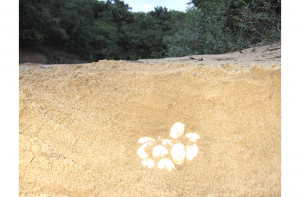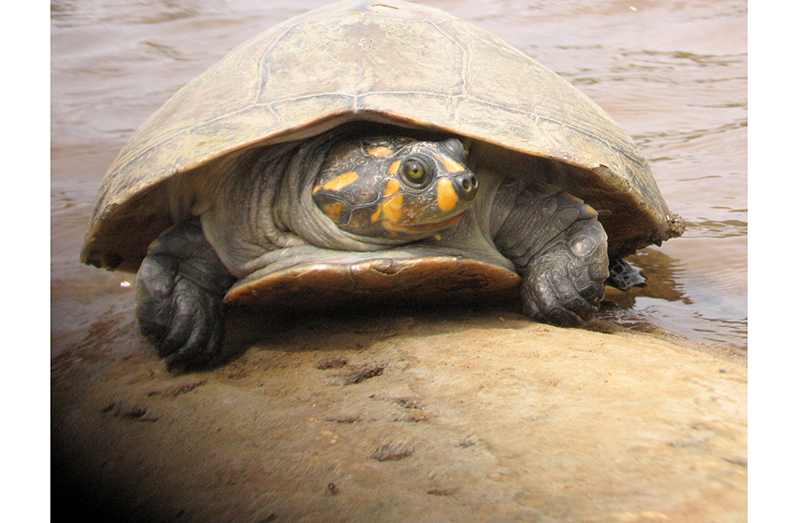By Telesha Ramnarine
EIGHT beaches on the Rupununi River, four of which now have formal protection, are being observed in an effort by the South Rupununi Conservation Society (SRCS) to increase the population of the Yellow-spotted River Turtle, which has seen a rapid decline over the years.
Classified in the scientific community, unofficially, as endangered, the reptile could have been found abundantly in the Rupununi, with villagers even having a traditional “turtle feast” around Christmas time. Over the past five years, though, it seemed that enough turtles could not be caught to facilitate the custom.
Back in 2015, the SRCS spoke to someone who frequents the river who had caught 92 turtles for Christmas that year, and it seems that the numbers were higher for each of the preceding years.
“In the 1990s, they were catching about 250 to 300 turtles each December. One man may go out around that time and in one night might catch 20 turtles,” Programme Coordinator for the River Turtle Monitoring Project Neal Millar said.

To increase the population of this species of turtle in the Rupununi, the SRCS has found it wiser to start the project by taking an interest in the turtle eggs, which villagers also love to eat. “It’s a specific delicacy and apparently it tastes very nice, although I have never had it myself,” said Millar.
And so as soon as the turtles lay their eggs, people will go on the sandbanks and harvest them. The turtle tracks on the sand, along with the little mounds that the turtles make after laying their eggs, aid the villagers in finding them.
The project was started in collaboration with the Sand Creek Village Council and has a team of eight rangers working on it, including assistants from the Protected Areas Commission (PAC).
“The area we’re working on is actually part of the Kanuku Mountain area that is protected and monitored by the PAC,” Millar noted, adding, “We went down the river where there are common nesting beaches and we identified eight beaches, four of which will now be under formal protection and the other four will be unprotected.”
The four protected beaches are Wuarad Baara, Pokoridin Baara, Pokoridwao Baara and Boizowoi Pao Baara.

A four-member team will go up and down the river every day to monitor the beaches and make records of how many nests they see; if there are any disturbances to the nests, etc. If anyone is seen disturbing the eggs on the four protected beaches, though, the team would try to educate them on the project and “disarm them in a friendly manner.”
This first phase of the project will last until about April when the hatching season will start. The team plans to allow the turtles to make their way to the river undisturbed and will then count the number of shells left behind to be able to tell how many turtles were hatched. The information can then be compared with that provided by the second four-member team observing the four unprotected beaches.
Depending on the success of the initial aspect of the project, the other phase will be implemented, which has to do with a harvesting ban. Signs will be put up to clearly indicate where villagers are not authorized to disturb the turtles and their eggs.

“No one from the village can go on the river and capture any of the turtles. If this project starts to be successful, our aim is to keep our monitors on the river the entire year to ensure that no one is harvesting the turtles,” Millar said.
A project similar to this one was started in 2012 but due to heavy rainfall over an extended period, it had to be cancelled. So the SRCS is trying again this time with funding from the Sustainable Wildlife Management Programme Guyana.
All the rangers are residents of Sand Creek Village apart from Asaph Wilson, who is a former resident of Sand Creek but now lives in Katoonarib Village. On Team One are Asaph Wilson, Keith Spencer, Hazelitha Bernadine, and Pearl Moses and on Team Two, Derrick David, Morano Barjoan, Tabitha Rebiero, and Fabekiel Thomas.
The SRCS makes it a point to achieve gender balance on the teams, even as it has been difficult to recruit female rangers because of stigma and safety reasons. Because the organisation has built up a trustworthy record, though, more and more youths, including females, have been coming forward to work on the projects.


